Larsen & Toubro Bundle
How did Larsen & Toubro become an Indian industrial giant?
From humble beginnings representing Danish dairy equipment manufacturers in 1938, Larsen & Toubro (L&T) has transformed into a global powerhouse. This Larsen & Toubro SWOT Analysis provides a deep dive into the company's strategic positioning. Its journey reflects India's industrial evolution.
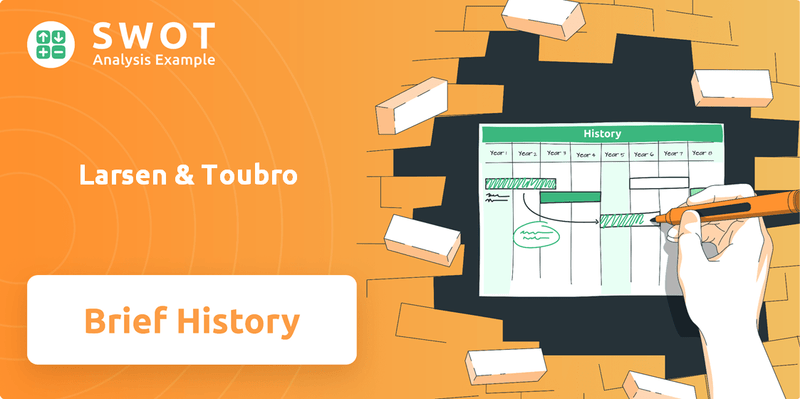
The
What is the Larsen & Toubro Founding Story?
The story of Larsen & Toubro, a prominent Indian conglomerate, began on December 2, 1938. It was founded by two Danish engineers, Henning Holck-Larsen and Søren Kristian Toubro. Their vision was to capitalize on the industrial development opportunities in India.
The founders saw a need for advanced industrial equipment and technical expertise within India. They started by importing and distributing machinery for the dairy and cement industries. This marked the beginning of what would become one of India’s largest engineering company.
This L&T history is a story of adaptability and growth, from its early days to its current status. The company's name, 'Larsen & Toubro,' reflects the partnership of its founders.
Larsen & Toubro (L&T) was established in 1938, marking the start of its journey as an Indian conglomerate. The founders, Henning Holck-Larsen and Søren Kristian Toubro, identified a gap in the Indian market.
- The initial focus was on importing and distributing machinery.
- They acted as agents for European manufacturers, providing essential equipment and support.
- World War II prompted the company to adapt by manufacturing spare parts and equipment locally.
- The company's early success was built on trading and representing foreign companies.
The initial problem they addressed was the lack of sophisticated industrial equipment in India. They acted as agents for European manufacturers, supplying machinery and technical support. The outbreak of World War II caused challenges with imports, leading L&T to manufacture spare parts and equipment locally. This shift was crucial for the L&T company origins.
The company's early operations were centered in Mumbai. The founders likely used their own funds and early revenues to finance the business. The company's name reflects the partnership of its founders, symbolizing their commitment to India's industrial advancement. The context of British India, with its growing demand for infrastructure, played a key role in the company's creation. For more details on the company's operations, consider reading about the Revenue Streams & Business Model of Larsen & Toubro.
The early years of L&T were marked by strategic adaptations and a focus on meeting the needs of a developing industrial landscape. This laid the groundwork for its future expansion and diversification. The company's ability to adapt during wartime and its focus on local manufacturing were key to its initial growth. This period is a crucial part of the L&T timeline.
Larsen & Toubro SWOT Analysis
- Complete SWOT Breakdown
- Fully Customizable
- Editable in Excel & Word
- Professional Formatting
- Investor-Ready Format
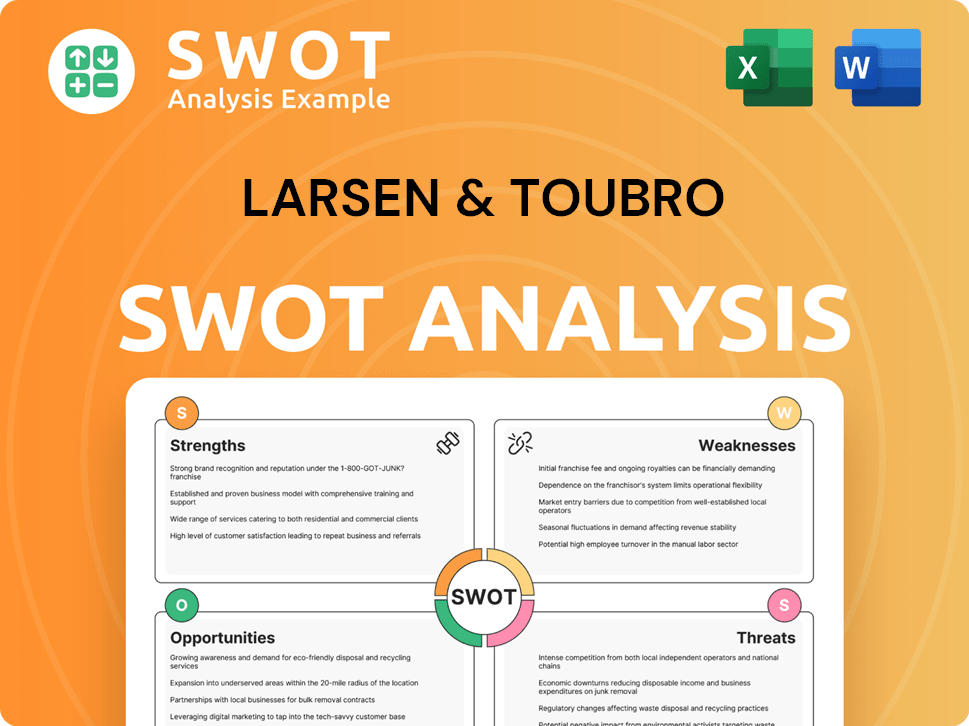
What Drove the Early Growth of Larsen & Toubro?
The early growth of Larsen & Toubro, or L&T, showcases a strategic shift and expansion in response to India's changing industrial needs. Following the disruptions of World War II, L&T transitioned from a trading firm to a manufacturing entity, a pivotal move in its L&T history. This transition involved the establishment of workshops and the production of essential equipment, setting the stage for its future as a leading Indian conglomerate.
After World War II, L&T began manufacturing soda ash and caustic soda plants. The company also established workshops to produce equipment for various industries. This shift was crucial for its early growth and diversification, marking a significant step in the L&T company's evolution.
In 1946, L&T took over the engineering and construction operations of Willcox (Buckwell-India) Limited, marking its formal entry into the construction sector. This move was a strategic investment in its future, setting the foundation for numerous L&T infrastructure projects. This expansion was a key milestone in the L&T timeline.
L&T launched its first major product, the 'L&T Series 100' switchgear, in 1947. This marked its entry into the electrical equipment manufacturing sector. This product launch was a significant step in its expansion and diversification, contributing to the L&T company growth.
The 1950s and 1960s were periods of significant growth, with the establishment of joint ventures and subsidiaries like Caterpillar (India) Limited in 1945. L&T also ventured into manufacturing drilling equipment and cement machinery, expanding its portfolio. These expansions were key L&T key milestones.
Larsen & Toubro PESTLE Analysis
- Covers All 6 PESTLE Categories
- No Research Needed – Save Hours of Work
- Built by Experts, Trusted by Consultants
- Instant Download, Ready to Use
- 100% Editable, Fully Customizable
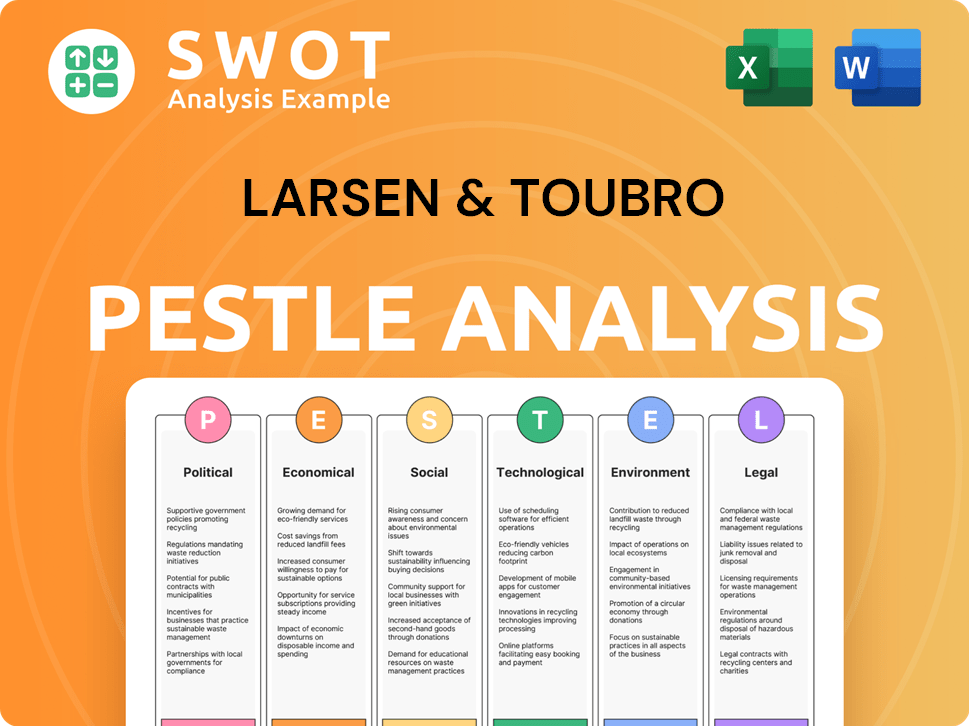
What are the key Milestones in Larsen & Toubro history?
The L&T history is marked by significant milestones that showcase its evolution from a trading firm to a leading Indian conglomerate. These achievements highlight its growth and diversification across various sectors, solidifying its impact on India's industrial landscape.
| Year | Milestone |
|---|---|
| 1938 | Larsen & Toubro was founded in India by Henning Holck-Larsen and Søren Kristian Toubro. |
| 1940s | L&T begins its journey in construction and engineering, expanding its scope. |
| 1970s | L&T develops India's first indigenously built nuclear reactor vessel, showcasing its heavy engineering capabilities. |
| 1980s | L&T diversifies into software services, leading to the formation of L&T Infotech (now LTIMindtree). |
| 2003 | L&T demerges its cement business, focusing on core engineering and construction strengths. |
| 2024 | L&T continues to secure major infrastructure projects and expand its global presence. |
Throughout its history, Larsen & Toubro has consistently embraced innovation, driving advancements across its diverse business segments. The company has secured numerous patents, reflecting its commitment to technological leadership and pioneering solutions.
L&T designed and built India's first indigenously built nuclear reactor vessel, demonstrating its heavy engineering capabilities. This innovation was crucial for India's strategic and technological advancement in the 1970s.
The diversification into software services, leading to L&T Infotech (now LTIMindtree), showcases L&T's adaptability to new technologies. This expansion broadened the company's revenue streams and market reach.
L&T has secured patents in advanced manufacturing techniques, enhancing efficiency and product quality. These innovations improve the company's competitiveness in the global market.
The company has also developed innovative construction methodologies for complex projects. These methods help to reduce project timelines and improve cost-effectiveness.
L&T's foray into renewable energy projects reflects its adaptability to evolving market demands. This strategic move positions the company in the growing sustainable infrastructure sector.
L&T has entered into collaborations in defense and aerospace, bringing cutting-edge solutions to India. These partnerships enhance the company's strategic capabilities and technological advancements.
Despite its successes, L&T has faced numerous challenges, including economic downturns and intense competition. The company's ability to adapt and innovate has been crucial in overcoming these obstacles.
Economic downturns, such as the Asian financial crisis in the late 1990s and global recessions, impacted project pipelines. These events necessitated strategic adjustments and cost-saving measures.
Competition from both domestic and international players in various segments required continuous innovation. L&T has focused on enhancing operational efficiency to maintain its market position.
The company navigated internal crises, including leadership transitions and strategic realignments. These situations required agile decision-making and effective change management.
The demerger of the cement business in the early 2000s allowed L&T to focus on its core strengths. This strategic pivot improved operational efficiency and resource allocation.
L&T's commitment to technological self-reliance has been a key factor in its resilience. This focus has enabled the company to adapt to changing market conditions and maintain a competitive edge.
Agile strategic planning has been essential for navigating challenges and seizing opportunities. This approach allows L&T to respond quickly to market changes and maintain its growth trajectory.
Larsen & Toubro Business Model Canvas
- Complete 9-Block Business Model Canvas
- Effortlessly Communicate Your Business Strategy
- Investor-Ready BMC Format
- 100% Editable and Customizable
- Clear and Structured Layout
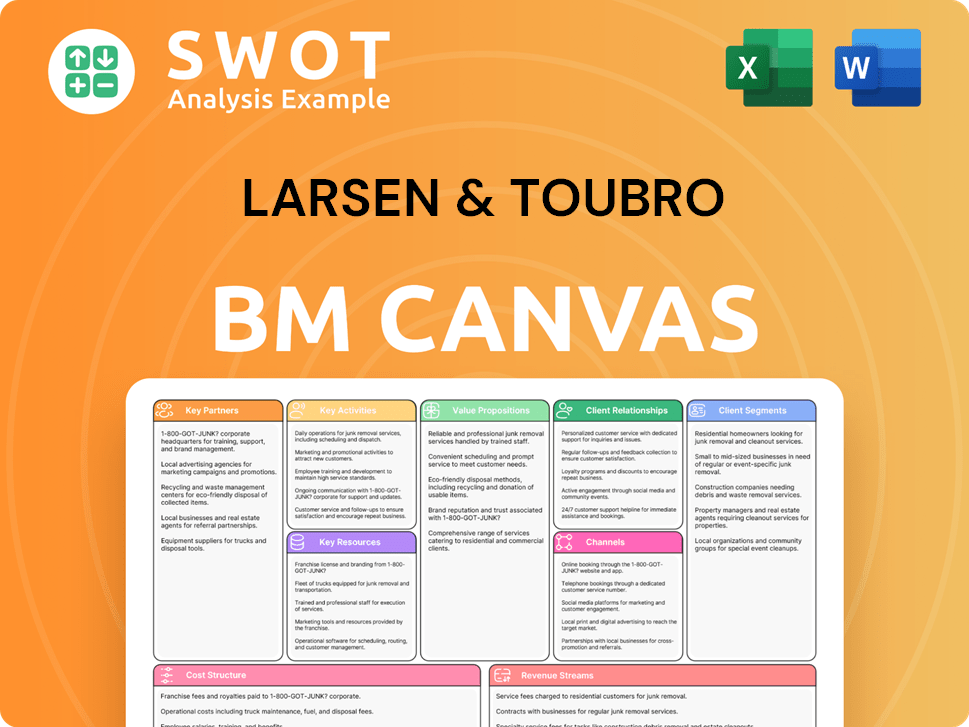
What is the Timeline of Key Events for Larsen & Toubro?
The L&T history is a testament to its evolution from a modest partnership to a global engineering and construction powerhouse. Founded in 1938, the company has consistently adapted and expanded its capabilities, playing a pivotal role in India's industrial growth and infrastructure development. From pioneering engineering feats to strategic acquisitions, L&T has navigated market dynamics, emerging as a diversified conglomerate with a significant global footprint.
| Year | Key Event |
|---|---|
| 1938 | Henning Holck-Larsen and Søren Kristian Toubro founded the company in Mumbai. |
| 1944 | Engineering Construction Corporation (ECC) was established, later becoming a wholly-owned subsidiary. |
| 1947 | The company began manufacturing switchgear, marking its entry into electrical equipment. |
| 1950 | Larsen & Toubro became a public company. |
| 1965 | Completed India's first indigenously designed and built nuclear reactor vessel. |
| 1970s | Diversified into heavy engineering and shipbuilding. |
| 1980s | Entered the information technology sector. |
| 2003 | Demerged its cement business, focusing on core EPC and manufacturing. |
| 2012 | Commissioned India's first indigenously built nuclear power plant unit. |
| 2018 | Acquired Mindtree, significantly expanding its IT services portfolio. |
| 2023 | Announced plans for significant investments in green energy and digital technologies. |
| 2024 | Reported robust financial performance, with Q4 FY24 revenues growing by 15% and net profit by 10% year-on-year. |
L&T is heavily investing in green hydrogen and renewable energy infrastructure. This aligns with global climate goals and India's energy transition. For example, in 2023, L&T signed an MoU with HydrogenPro for large-scale green hydrogen projects. These initiatives reflect L&T's commitment to sustainable and eco-friendly solutions, helping the company to lead the way in the green energy sector.
The company is focusing on advanced manufacturing, defense, and digital transformation. They are leveraging technologies like AI, IoT, and automation to boost efficiency and create new revenue streams. These technological advancements are key to L&T's strategy, ensuring it remains competitive and innovative in a rapidly changing market landscape.
L&T aims to be a leader in the global EPC space, with significant expansion plans in international markets. The Middle East and Africa are key regions for this expansion. This global strategy aims to diversify the company's revenue streams and increase its international presence, contributing to long-term growth and stability.
Analyst predictions suggest continued growth driven by India's infrastructure push and increasing global demand. L&T's leadership is committed to innovation and operational excellence. The company's focus remains on strengthening its position as a diversified conglomerate, building on its rich history and looking towards a future of sustained growth.
Larsen & Toubro Porter's Five Forces Analysis
- Covers All 5 Competitive Forces in Detail
- Structured for Consultants, Students, and Founders
- 100% Editable in Microsoft Word & Excel
- Instant Digital Download – Use Immediately
- Compatible with Mac & PC – Fully Unlocked
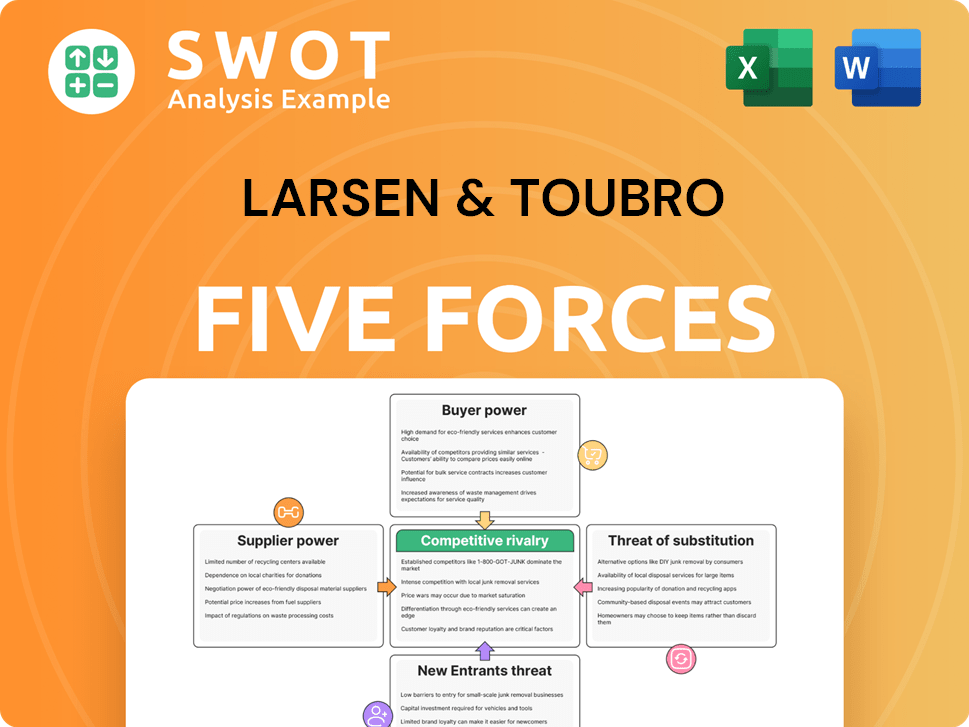
Related Blogs
- What is Competitive Landscape of Larsen & Toubro Company?
- What is Growth Strategy and Future Prospects of Larsen & Toubro Company?
- How Does Larsen & Toubro Company Work?
- What is Sales and Marketing Strategy of Larsen & Toubro Company?
- What is Brief History of Larsen & Toubro Company?
- Who Owns Larsen & Toubro Company?
- What is Customer Demographics and Target Market of Larsen & Toubro Company?
Disclaimer
All information, articles, and product details provided on this website are for general informational and educational purposes only. We do not claim any ownership over, nor do we intend to infringe upon, any trademarks, copyrights, logos, brand names, or other intellectual property mentioned or depicted on this site. Such intellectual property remains the property of its respective owners, and any references here are made solely for identification or informational purposes, without implying any affiliation, endorsement, or partnership.
We make no representations or warranties, express or implied, regarding the accuracy, completeness, or suitability of any content or products presented. Nothing on this website should be construed as legal, tax, investment, financial, medical, or other professional advice. In addition, no part of this site—including articles or product references—constitutes a solicitation, recommendation, endorsement, advertisement, or offer to buy or sell any securities, franchises, or other financial instruments, particularly in jurisdictions where such activity would be unlawful.
All content is of a general nature and may not address the specific circumstances of any individual or entity. It is not a substitute for professional advice or services. Any actions you take based on the information provided here are strictly at your own risk. You accept full responsibility for any decisions or outcomes arising from your use of this website and agree to release us from any liability in connection with your use of, or reliance upon, the content or products found herein.